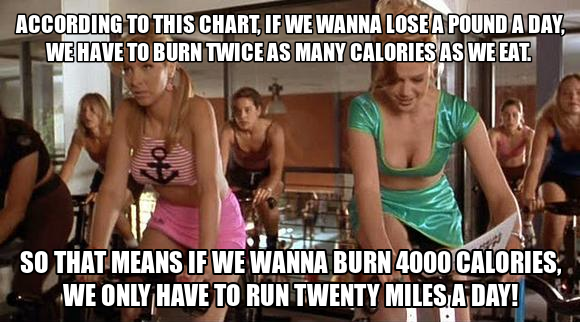
Do you shy away from heart rate monitors because you’re not sure how to use one? Is it the chest strap or bulky, ugly watch that turns you off? Are you confusing it with a pacemaker and don’t think you need one for at least another 40 years? (NEWSFLASH: They’re very different.) For me, it was the price and lack of understanding the “zones” that scared me off for so long. But now I wear it at least once a week to any class I teach or take and tell all of my clients to get one.
So why should you draw any attention away from your perfectly stylish fitness gear by adding a lame watch and chest strap to your body? Well, because if you are in any way concerned about losing weight, getting lean, and increasing your fitness level through your workouts (to look even better in that Lulu ensemble), then you should know if said workouts are really doing your body any good. The only way to know exactly what your body is burning during a workout is to wear a heart rate monitor instead of relying on a machine or computer to give you an estimated calories burned.
First, know that you don’t have to wear this every single time you go for a run, take a class, or hit the gym. The purpose of this customized accessory is to give you a reality check and show you:
- If your exercise of choice is even worth your time!
- If you need to go a little longer or harder to get the burn you require (read: allowing you to enjoy that extra glass of wine).
- If you are burning the number of calories you THINK you are.
- What it feels like to push outside of your comfort zone for a true interval workout and how to make this happen on your own.
(Ladies, don’t shoot the messenger, but if you’re using the elliptical for an hour at a resistance of 2 and barely breaking a sweat, you’re wasting your precious time.)
Heart Rate Monitor 101:
1. Don’t wait until you pull up to the gym/studio or put your running shoes on to take it out of the box. Take the time to set it up the night before so you are ready to use it quickly.
2. Follow the simple instructions on the watch to enter your height, weight, activity level, etc. (Click here for more direction on determining your activity level.)
3. If you want the best results, customize it by finding your own max heart rate rather than rely on the one it sets for you. An easy way is to get on a stationary bike, push start on the watch and go hard (seriously hard, breathless, maybe not in front of your crush) for 20 minutes then push stop. Take the average heart rate it gives you and make that your new max heart rate. If you’re not feeling this, no worries! It’s just a bit more accurate and helpful for reaching your fitness goals.
4. Wear the strap under the bottom of your sports bra touching your skin. If you have a “modest” chest region like me, it might show through your tank, but if you have a decent rack, it will never be seen and you’ll probably forget it’s even there!
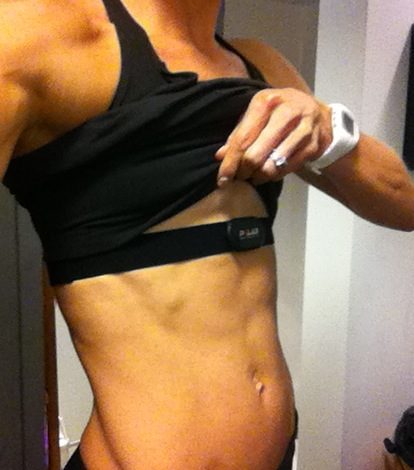
Now that you have it on and are ready to sweat, let’s break down the output as simply as possible.
Below are three images of my watch for a 45-minute Flywheel cycling class that I taught. There are three specific sets of data given.
1. Average and max heart rate during the class. This is how hard my heart had to work to get oxygen to my body during my workout so that I could keep going. Use this to see if over time you can decrease your average heart rate during the same intense workouts and therefore improve the strength of your heart and fitness level.
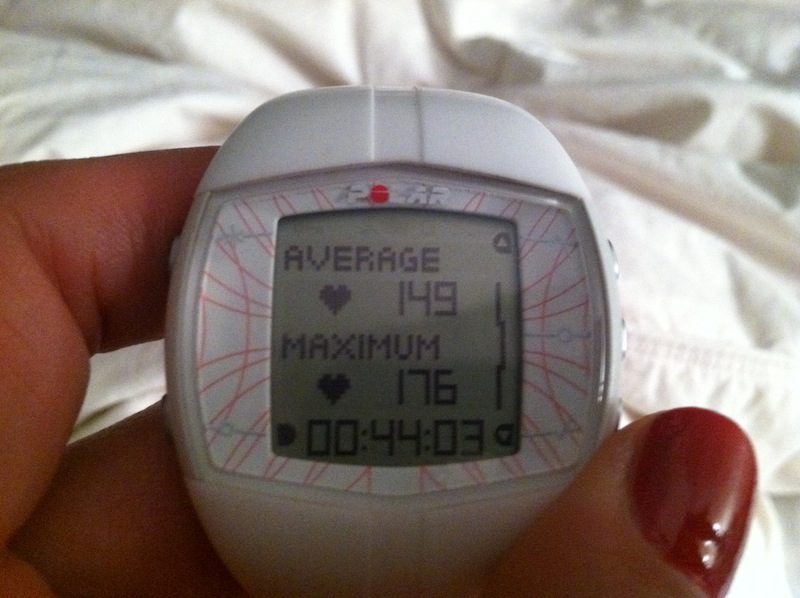
2. Time spent in the fat burning and fitness zones. First let me explain what these zones are and why you need to forget about the fat burning zone altogether. The fat burning zone is where your heart rate level is around 60-75% of your max heart rate and the calories your body burns are made up of a higher percentage (not all) of fat vs. sugar. People that need to lose 20 pounds or more work out in this zone while they’re trying to lose the initial weight.
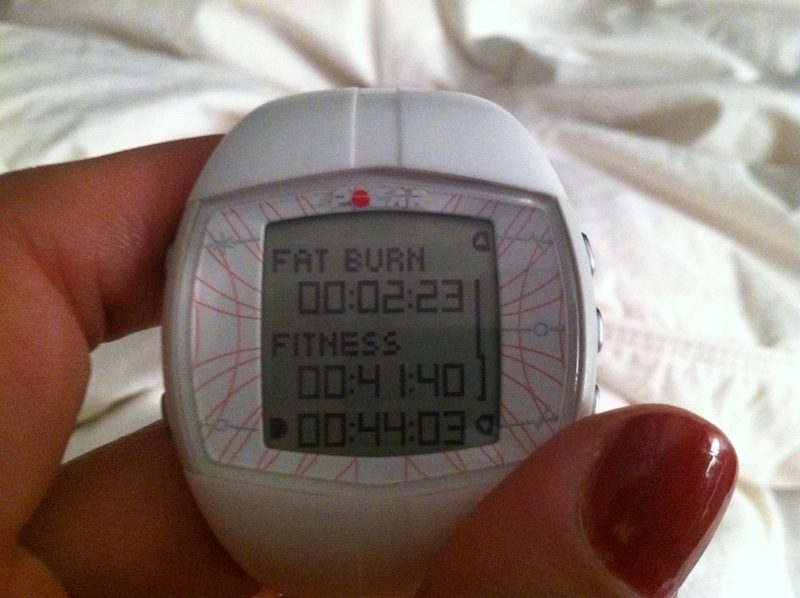
As appealing as the fat burning zone sounds, it’s probably not what you think it is and staying in it is NOT THE GOAL! In order to burn a significant amount of calories with your heart rate in this zone, you would have to work out for hours.
The FITNESS zone is the one you want to get all over, my friends. We’re talking interval cardio, circuit training, building muscle (where more fat is burned), spinning, CrossFit, P90X, and getting breathless in a workout for at least 20 minutes. This zone is where the magic happens (more calories burned in less time) and what produces the beautiful afterburn effect, or what I like to call “calories burned while sitting on your couch hours after your workout!”
3. And finally, the total calories burned in my workout with the percentage from fat calories (about 100 here). Going back to the zones; if you completed a 44 minute walk/jog staying in the fat burn zone the whole time, then you would probably only burn a total of 200 calories with about 50-60% of these as fat calories. More info on calories here if you really want to educate yourself.
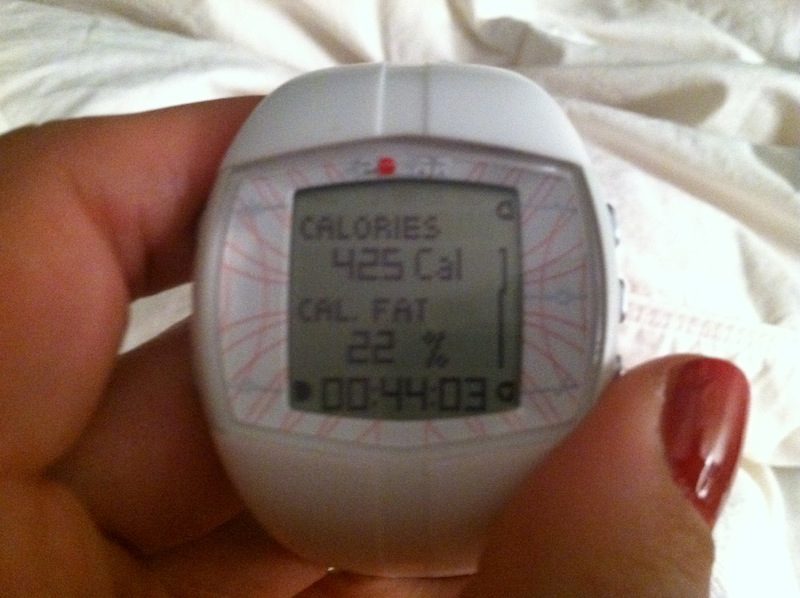
Your total calorie number is calculated based on your heart rate so if you are lifting weights, you will see a lower total calorie burn (and honestly don’t need to wear the watch during a weight-focused workout or barre/Pilates-type class). But remember–you should be doing weight training if you want to get lean, because fat is actually burned in muscle and each pound of beautiful muscle burns significant calories just sitting there.
As for which heart rate monitor to choose:
I have always used the Polar brand and the basic one is all you need. The difference in that model and the slightly pricier one I use is that mine has a feature that keeps it from interfering with other monitors (and I spend the majority of my workouts in a room full of people so that’s important). If you run outside or work out at home, go for the cheaper one!
And a few DON’Ts to keep in mind:
1. Don’t compare your data to your 6′ tall friend that played volleyball in college or your boyfriend. Bodies are like engines: Some are a v6 and some are a v8. The more engine you have, the more calories burned, so don’t fret if you kicked your own ass in a class alongside your Gabrielle Reece body double friend and she burned way more cals.
2. Don’t stress about the zones! There are some watches with like, four zones and I don’t even know what they all really mean! It doesn’t have to be so complicated; Just get out of breath and work hard during your workout, then recover by focusing on breathing slowly. Then repeat! Use the fat burning zone if you need to drop more than 20 pounds and haven’t exercised in a while until you build up your fitness level to do intervals. Walking, light jogging, and riding a stationary bike is the best way to get in this zone and stay there for 45-60 minutes to burn excess fat. Do this 4-5 days a week and you will drop the initial 10 pounds easily. For the person trying to tone up, maintain, or shed that last 5 pounds, hitting the fitness zone 3 -4 days a week for 30-45 minutes combined with weight training will get you to your goals quickly.
3. Don’t get obsessed with the calories burned. This number will vary depending on how much sleep you get, food you had, “time of the month,” stress you’re under, and even the mood you’re in. Weight training and resistance classes like Pilates, barre, and yoga are not going to put out a big calorie burn out like running or cycling does, but like I said before, you need resistance training to build and maintain lean body mass which burns calories on the couch.
And last (but certainly not least), let’s talk metabolism:
If you have found yourself unable to shed those last five pounds, hitting an exercise plateau, or are just starting to get into exercising again after a while, then you should take a closer look at your metabolic rate and make the necessary adjustments for calories in vs. calories out if you want to see change happen. First, determine how many calories you need throughout the day (your metabolic rate) based on the “activity level” you have a more accurate view of now.
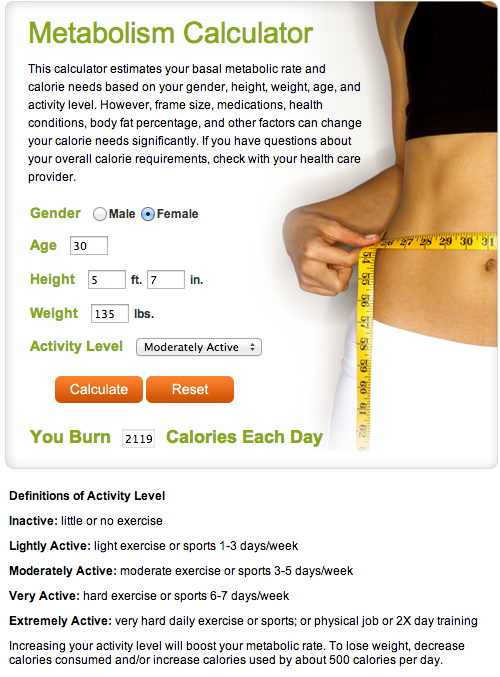
Then, if you are trying to lose weight, eat less than this amount, but don’t go starving yourself! Keep your calorie deficit around 250-350 (especially if you’re doing “fitness zone” training), so you don’t send your body into starvation mode where it will resort to storing fat and using your lean tissue for energy instead (the HORROR!). In other words, those 1200-calorie-a-day diets are only going to hurt you in the long run. Losing weight the right way to keep it off is a marathon, not a sprint. Here’s a helpful and more in-depth article if you’re interested.
Hope you enjoyed this novel, learned a little something, and are ready to strap on a heart rate monitor and work it out!
Happy sweating!
Cara
